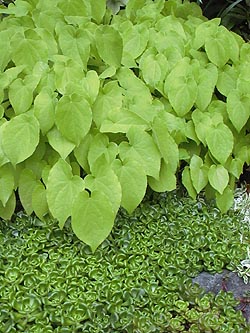Epimedium alpinum
ALPINE BARRENWORT
Family: Berberidaceae
Pronounced: ep-ee-MEE-dee-um al-PINE-um
Quick Jumps
Growing Guide
Rainy Side Notes
GROWING GUIDE

Origin:
Southern Europe.
Plant Group:
Perennial.
Hardiness:
Sunset zones: 1-9, 14-17.
USDA zones: 4-9.
Heat zones: 9-4.
Mature size:
Height: 6-12 inches (15-30 cm).
Width: 12 inches (30 cm).
Flowering period:
Mid to late spring.
Flowering attributes:
Racemes of 12-20 small flowers with red inner sepals and creamy-yellow petals, an almost spur-less flower, held below the leaves.
Leaf attributes:
Lime-green, heart-shaped, semi-deciduous leaves (evergreen in some areas of the Pacific Northwest.)
Growth habit:
Creeping habit.
Light:
Partial shade.
Soil:
Humus rich, fertile, well-drained, dry to medium soil.
Propagation Methods:
Sow seed as soon as ripe, and place in cold frame. | Divide in autumn or after flowering.
Pruning Methods:
Shear plants back to the ground in late winter so spring flowers will not be hidden in the old foliage.
Rainy Side Notes
Italian botanist Luigi Anguillaria (1571-1570), called this species Epimedio, in his only publication, Semplici (Venice 1561), the first mention of the species originating from Italy. Around the time it came into cultivation, the small perennial found its way into Belgian, French and German gardens. For a long time it was the only one of its genus known in Europe. Later, in 1739, Linnaeus named it Epimedium alpinum.
In the past it was thought that epimedium leaves beaten and added to wine would prevent conception for five days, if drunk after menstruation. In 1597, it was given the English name of ‘Barren Woort', by Gerard in London, "...because, as some authors affirme, being drunke it is an enimie to conception."
Two exceptional hybrids came from this species, E. x cantabrigiense, a cross between E. alpinum and E. pubigerum; and E. x rubrum a cross between E. alpinum and E. grandiflorum.
This deer resistant plant, Epimedium alpinum is easy to grow in the Pacific Northwest. It spreads by long rhizomes, and although slow to expand (8 to 12 inches a year), it is not polite to smaller plants. This drought tolerant ground cover is an excellent choice for dry shade. The bright, fresh green foliage is handsome growing as a colony under trees or large shrubs, lighting up the shade and crowding out weeds. Unless foliage is pruned in late winter, the flowers remain hidden.
Epimedium grows best in gardens sheltered from cold winds. Although considered semi-deciduous, it has proven to be evergreen in my own garden, where it grows under a large rhododendron.
Photographed in author's garden.

Gardening for the Homebrewer: Grow and Process Plants for Making Beer, Wine, Gruit, Cider, Perry, and More
By co-authors Debbie Teashon (Rainy Side Gardeners) and Wendy Tweton
Copyright Notice | Home | Search | Perennials

